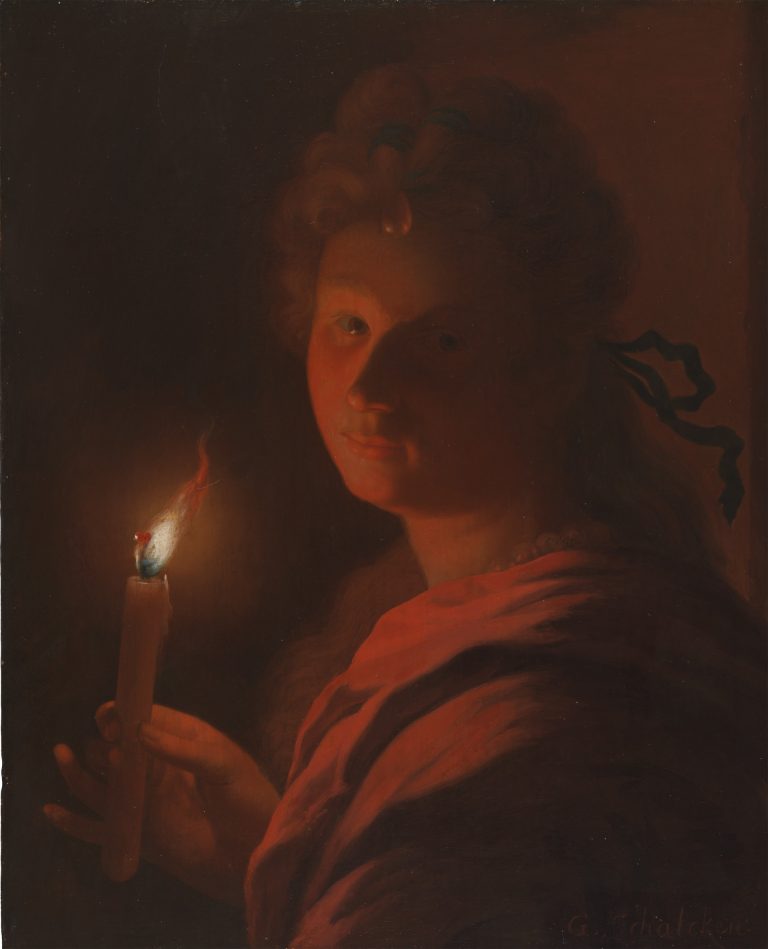Godefridus Schalcken received his first artistic instruction in Dordrecht in the studio of his fellow townsman Samuel van Hoogstraten (1627–78) beginning around 1656. This period of training certainly ended no later than May 1662, when Van Hoogstraten left for London.1 To complete his training, Schalcken then went to Leiden to study with Gerrit Dou (1613–75), where he probably remained until about 1664. Although no documents shed light on any of these movements, Schalcken did make a portrait etching of Dou with a text identifying the sitter as his revered teacher: Honoris ergo / Praeceptorum Su’um delineavit / G. Schalcken (fig 1).2 From 1672 onward Schalcken is frequently documented in the archives of Dordrecht, where he had probably returned by the mid-1660s.3
During his apprenticeship to Dou, Schalcken learned, among other things, the art of painting nocturnal lighting effects. During these years Dou produced a number of his most famous works in this genre, including both versions of The Evening School.4 Nevertheless, daylight genre scenes—such as depictions of old women reading, quack doctors and maidservants—dominated Dou’s oeuvre, and, similarly, Schalcken produced mainly small daylight genre scenes and only occasionally painted subjects with artificial illumination.5
Schalcken did not begin to paint many nocturnal scenes until the late 1670s.6 In fact, only after 1685 did the percentage of his work devoted to artificially lit scenes grow significantly, although night scenes were never so numerous as to represent the bulk of his oeuvre. The reason for Schalcken’s growing interest in candlelit scenes was probably Dou’s death in February 1675, which meant that Schalcken was the only master able to meet the demand for top-quality depictions in this specific genre. In the 1690s Schalcken displayed his mastery of this specialty in a series of candlelit self-portraits, and these technical tours de force made him famous in his lifetime.
Compositionally, Girl with a Candle would seem to belong to the second and socially most successful part of Schalcken’s 40-year career. Much as with his self-portraits, the young woman in this painting holds a candle in her right hand as she turns to look at the viewer. Her long curly hair is tied at the back with a blue ribbon and falls in waves over her right shoulder. The large pearl drop dangling on her forehead is fastened to a shorter blue ribbon, and she wears a string of pearls that is visible beneath the large red-orange shawl draped over her left shoulder. Nevertheless, the pictorial quality of the Leiden Collection panel is not at Schalcken’s level. The woman’s face lacks plasticity, and the fingers are rather stiffly executed. Moreover, her clothing is painted with little tonal differentiation, and the painting lacks local color: within the overall orange-red glow of the image, only the blue ribbons in her hair provide color accents.
Dendrochronological analysis of the panel provides reinforcing evidence that Schalcken did not execute this work: the tree from which the panel was hewn was felled around 1727, some 18 years after the artist’s death.7 The fact that paintings bearing Schalcken’s signature were made after his death is not unexpected. Schalcken’s widow, Françoisia van Diemen (29 August 1661–22 January 1744), who survived her husband by more than 30 years, inherited the paintings left in Schalcken’s workshop. She continued to sell paintings for many years, as documented by the sale of a painting in 1733 to Johan Nicolaas (van) Hafften, the agent of the duke of Mecklenburg-Schwerin. A municipal assessment of The Hague in 1742 indicates that “Francisca van Diemen, Wid(ow) Schalke, rentenierster” had 3,000 guilders worth of income that year.8 It is probable that she supplemented her income from interest and obligations, and from selling Schalcken’s autograph paintings, by commissioning copies of some of the works in her possession. These were likely executed by students of her late husband who resided in The Hague around 1730, among them her nephew Jacob Schalcken (ca. 1682–1733), Godefridus Callenfels (1683–1748), and Antonie de Waardt (1689–1751).9
Girl with a Candle is known in three other versions on three different supports. One of these, which was in the Staatliches Museum in Schwerin before the Second World War, was likewise painted on panel.10 A version on copper, which was sold by the Kunsthalle in Hamburg after the First World War, was last recorded with a London art dealer in 1938.11 Finally, a version on canvas was last documented in the early twentieth century.12 Copper was the most expensive of these supports, and it is probable that the version on copper, formerly in Hamburg, was Schalcken’s autograph painting.
